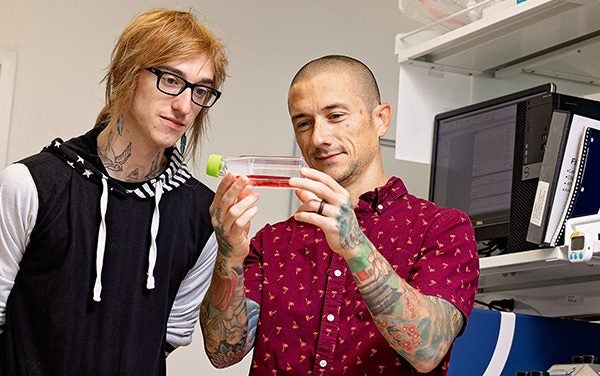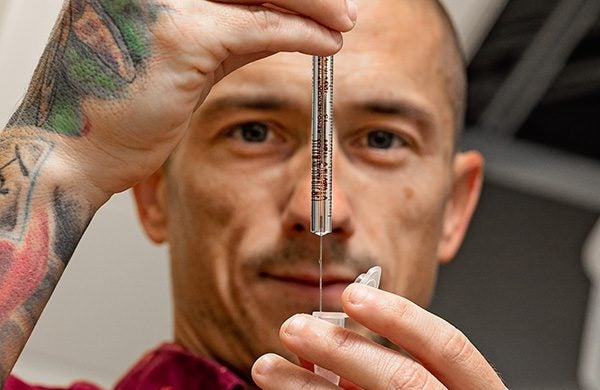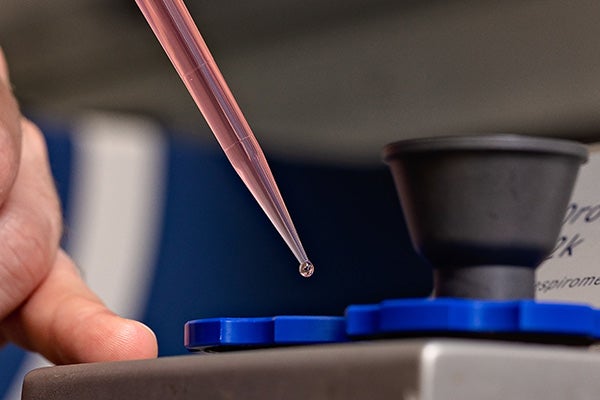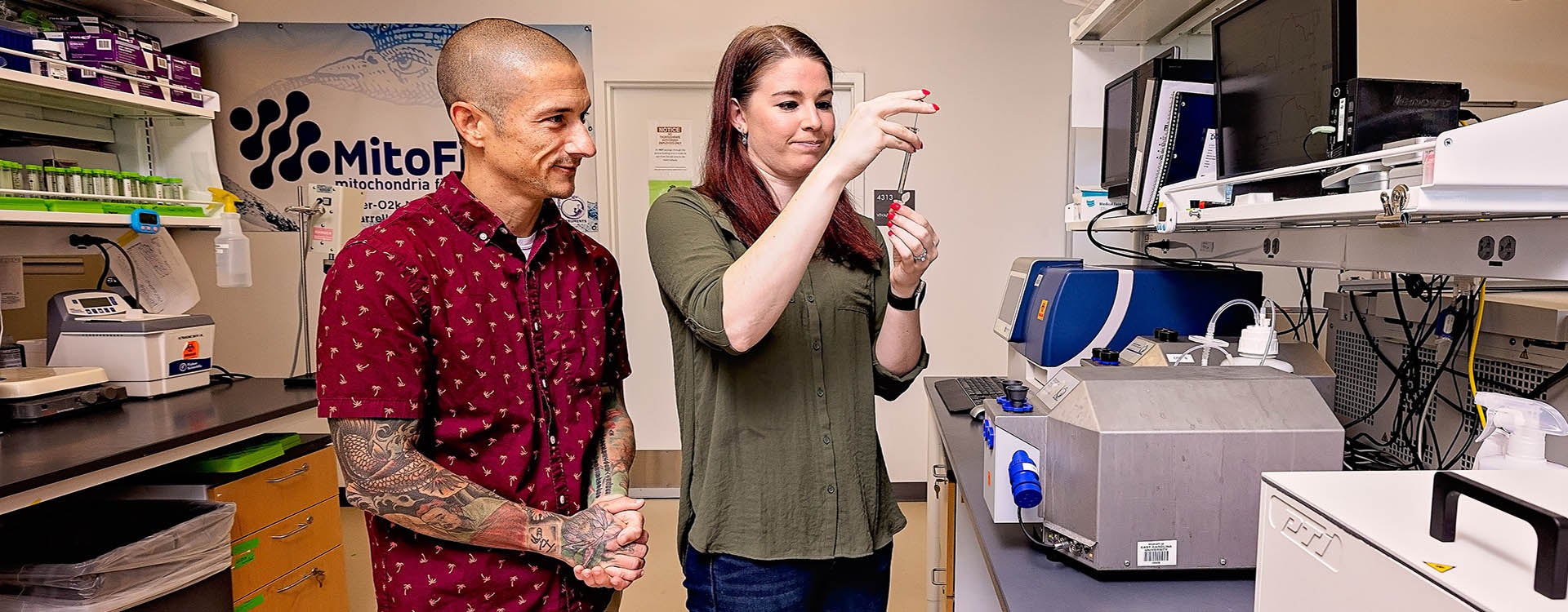ECU researchers target cell mitochondria for potential leukemia therapies
Researchers at the Brody School of Medicine at East Carolina University are exploring how differences in mitochondria — the powerhouse of cells — in cancer cells versus normal cells could yield therapies used to treat acute myeloid leukemia (AML).

• Dr. Kelsey Fisher-Wellman, right, and Tyler Hagen talk about their work in a lab in the East Carolina Heart Institute at ECU. (Photos by Cliff Hollis)
The research is led by Dr. Kelsey Fisher-Wellman and was recently published as “Intrinstic OXPHOS limitations underlie cellular bioenergetics in leukemia” in the journal eLife, a life sciences journal that publishes high-impact research across scientific disciplines. Fisher-Wellman is an assistant professor in Brody’s Department of Physiology and a researcher in the East Carolina Diabetes and Obesity Institute (ECDOI).
AML is a particularly aggressive type of leukemia that interferes with the production of normal white blood cells, red blood cells and platelets. Treatments typically include chemotherapy, other drug therapy and stem-cell transplants.
“It’s one of the most common blood cancers in adults. It’s definitely one you don’t want; it’s fairly aggressive and your prognosis tends to get worse if you are older when you get it,” Fisher-Wellman said. “The standard for treating AML, which is a combination of chemotherapies, has really stayed the same for the past 40 years. It’s definitely one of those cancers that would benefit from novel therapies.”
That’s where the Fisher-Wellman Lab — which began in 2018 and investigates intrinsic alterations across the mitochondrial network in cancer — comes in.
Fisher-Wellman said the work in his lab builds on discoveries made by others over the years across research and cancer research disciplines. His team has the tools to delve deeper and take a closer look at how differences in mitochondria in AML cells could be targeted with potential therapies.
“We’re doing what people in the field have led the way in,” Fisher-Wellman said. “We’re just following suit.”
The secrets of the cell
The research builds on basic phenotyping — identifying a set of observable characteristics in a cell — and uses more sophisticated methods and tools to take that phenotyping to new ground.
“Essentially, we discovered that the mitochondrial biology of the AML cell is unique,” Fisher-Wellman said. “Because the cancer cell has a different phenotype than the normal cell, it will have to have a different metabolism to meet the demands of its unique phenotype. What we do is try and figure out what it is specifically about the metabolism of the cancer cell that’s critical to it being a cancer cell, then we go one level deeper and intrinsically evaluate the energy producing portion of the cell, which would be the mitochondria.”
The next question was the basis for the paper’s hypothesis: “If we can find specific mitochondrial phenotypes that are responsible for the cancer, can we target those specific phenotypes?” Fisher-Wellman said. “You’re trying to find something, some biology, that separates the cancer cell from the normal cell.”

Dr. Kelsey-Fisher Wellman is leading a team of researchers to investigate differences in leukemia cell mitochondria that could be targeted with cancer therapies.
The problem in health care becomes clear when cancer is compared to other health problems like heart failure. A cardiologist doesn’t treat heart failure by killing heart cells, for example.
“But cancer is this weird disease where you actually have to kill —eradicate — the bad cells but not the good cells,” Fisher-Wellman said. “And how do you do that? It’s difficult. You have to find something that is unique, some vulnerability that is only present in the cancer. So that was the point of the paper. We hypothesize that maybe there’s something unique in mitochondria of leukemia cells that can be therapeutically targeted.”
The team built off ideas already discovered in the realm of cancer metabolism research, including an existing precedent to find and target mitochondria in cancer cells. Then, however, they took it a step further.
Using their methods, the team could see that AML mitochondria are unique from normal cells. Rather than making ATP — adenosine triphosphate, the primary carrier of energy in cells — they consume it. In the paper, that unique metabolic feature is described, and the researchers found that “you can target this phenotype using small molecules that specifically block the ability of AML to consume ATP,” Fisher-Wellman said. “This therapy proved to be highly cytotoxic to AML, but importantly, did not show cytotoxicity across normal cells. What was really exciting for us is that the ATP consumption phenotype became even more pronounced in the context of AML chemoresistance.”
Because chemoresistant AML cannot be treated with conventional therapies, the team is pursuing its mitochondrial-targeted approach to both predict and intervene at the bedside to combat drug resistance.
Bedside implications
The mitochondrial research was funded initially by a Department of Defense grant and then one from the Brody Brothers Foundation, which was founded in 1999 when the Brody family of eastern North Carolina donated $7 million to fund research projects at the medical school. Since awarding its first grants in 2005, the foundation has provided more than $1.1 million to support work related to diseases that most impact the lives of North Carolinians.
The Department of Defense funding focused on isolating mitochondria in a lab setting and studying them in a “semi-natural habitat,” Fisher-Wellman said. The research led to the discovery that mitochondria behave differently in leukemia cells, consuming ATP instead of creating it. When that supply of ATP was cut off, the leukemia cells died off. Understanding that behavior is essential in targeting those cells in cancer treatment.

Dr. Kelsey Fisher-Wellman’s research focuses on acute myeloid leukemia, an aggressive type of blood cancer.
“This type of insight is precisely what is needed to give us a chance at a truly cancer-specific mitochondrial targeted therapy,” Fisher-Wellman said.
The Brody Brothers grant comes at cancer from the other side.
“The ideal drug treatment strategy would be to find a mitochondrial dependency that is on one hand, bad for cancer, but on the other hand, good for the immune system,” Fisher-Wellman said. “In short, we know that both cancer and immune cells need their mitochondria, but perhaps they need them for different things.”
The combined funding support helped equip the researchers to conduct more complex testing on those ideas.
“We had the tools to make sophisticated measurements of mitochondrial metabolism and we knew if there were differences there, we would be able to find them,” Fisher-Wellman said. “We were not confident in whether or not we could do anything with what we found, but I think you could argue that we got lucky.”
While there is a lot of work that needs to be completed moving forward with the knowledge of potential mitochondrial targeting in cancer treatment, Fisher-Wellman sees that the stakes are higher from past research contexts because of the possibilities for patients.
“You’re seeing tumors that come from real people,” he said, “and you have the potential to impact the outcomes for future cancer patients. You realize that you’re actually really close to the bedside. Somehow, I’ve found myself right next to it.”
Collaborations fuel hope
The paper’s contributors of ECU providers and researchers — from Brody’s physiology, internal medicine, biochemistry and molecular biology, cardiovascular sciences and surgery departments as well as the ECDOI — demonstrates how collaboration and interprofessional scholarly work can lead to potential therapies with better patient outcomes. The contributors include Dr. Darrell Neufer, Dr. Nasreen Vohra, Dr. Darla Liles, Dr. Myles Cabot and Dr. Joseph McClung.
Additional contributors include Dr. Margaret Nelson, Kelsey McLaughlin, James Hagen, Hannah Coalson, Cameron Schmidt, Miki Kassai, Kimberly Kew and Patricia Brophy.
“I could do the bioenergetics side, and I was confident that my lab could isolate mitochondria and phenotype them in the context of cancer,” Fisher-Wellman said. “But I needed help.”
That’s where key partnerships came into play.
Without a background in cancer biology, other experts were needed to provide vital parts of the project. Neufer, director of ECDOI and Fisher-Wellman’s Ph.D. mentor, introduced him to Cabot, who provided the cells that generated the initial data.
“Myles is one of my science heroes,” Fisher-Wellman said. “He’s a really big reason why we had our early success. He just happens to be an expert in leukemia biology, and I show up
I want to study cancer. He has the model systems, and I said, ‘Let’s put those together and see what we can find.’”
Along the way, the team recruited clinicians, including Vohra and Liles, who as physicians provided cancer cells via tumors, bone marrow and other tissue under an institutional review board that covers all cancers. Vohra serves as co-principal investigator on the Brody Brothers grant, brings expertise in cancer immunology and is “a major driver of the immune system side of our research,” Fisher-Wellman said.
“We’re working together to try and figure out what things mean and take the next step to where we can get closer and closer to really bridging the two worlds of what we’re doing over here in our scientific benches and what they’re doing over there … [in the clinic] …, which is admittedly a tougher space,” he said. “You feel this obligation to really get the science right, to do it justice.”
Fisher-Wellman added that the level of commitment in these collaborations point to a unique feature of ECU research.
“That’s one of the things I love about this university,” he said. “Everybody on this paper contributed something unique that together allowed us to do more than we could have done independently, and that speaks to the collaborative environment of our institute and the Brody School of Medicine.”

Dr. Kelsey Fisher-Wellman, left, and Kelsey McLaughlin work in the lab.